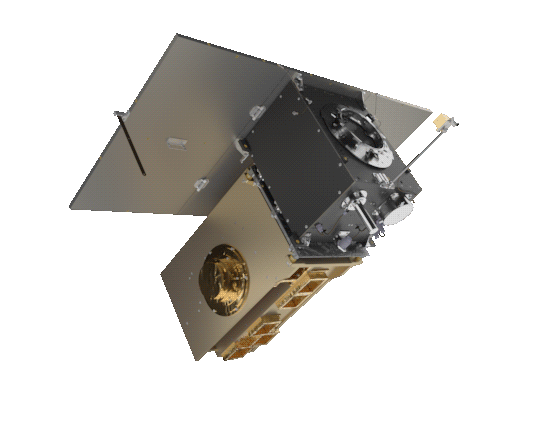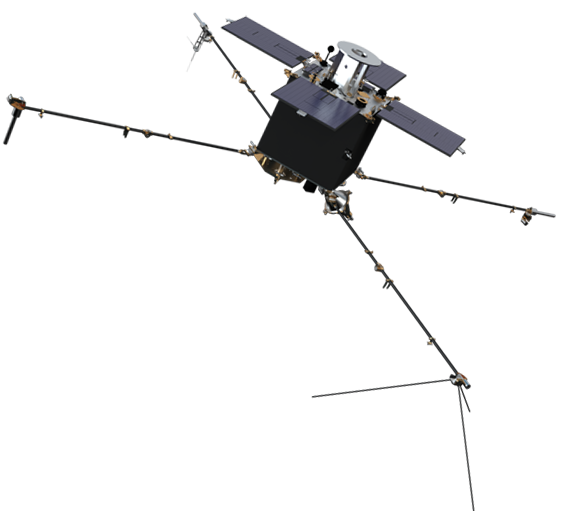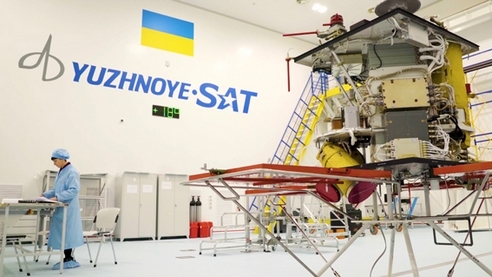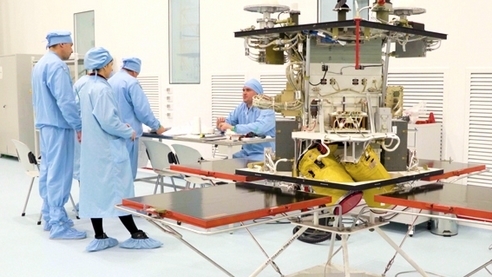Scientific spacecraft
Scientific spacecraft
Scientific spacecraft
SCIENTIFIC SPACECRAFT
YUZHSAT-1
YuzhSat-1
SCIENTIFIC SPACECRAFT
DESCRIPTION
MAIN SPECIFICATIONS
| Mass, kg: | 38.4 |
| Orbit: | |
| – type | circular sun-synchronous |
| – altitude, km | ~705 |
| – inclination, deg | ~98.1 |
| Orientation: | |
| – type | 3-axis active |
| – actuating devices | magnetorquers, reaction wheels |
| Payload supply power, W: | |
| – maximum | 80 |
| – daily average | 20 |
| Tilting range, deg | ±35 |
| Orientation accuracy, deg | 0.2 |
| Stabilization accuracy, deg/s | 0.01 |
| Orientation determination accuracy, deg | 0.1 |
| Design life, years | 2 |
PAYLOAD BASIC SPECIFICATIONS
Aerosol-UA Scientific Equipment Complex
Scanning photometer-polarimeter (ScanPol)
| Operating wavelength, cm | ~3.1 (X-band) |
| Scanning along ground track from nadir, deg | +50/-60 |
| Photometric accuracy, % | 5 (10% for 1378 nm and 1610 nm) |
| Polarimetric accuracy, % | 0.2 |
| Polarimetric stability, %/year | 0.2 |
| I, U, Q Stokes parameters in 6 spectral bands at a time | |
| Spectral bands, nm | 370, 410, 555, 865, 1380, 1610 |
| Spectral channel transmission windows, nm | 20 (60 for 1380 and 1610) |
| Signal/noise | ~2000 for albedo 0.1 and solar zenith angle 60 deg (400 for 370 nm channel) |
| Field of view along flight path, deg | 0.5 |
| Nadir resolution, km | ~6 |
Multispectral imager-polarimeter (MSIP)
| Spectral bands, nm | 410, 555, 865, 1380 |
| Spectral channel transmission windows, nm | 40 (60 for 1380) |
| Signal/noise | 100 for albedo 0.1 and solar zenith angle 60 deg |
| Pixel size at the surface | 500 m |
| Imaging along ground track with spatial resolution in nadir, km | ~3 |
| Visual field size, deg | 60х60 |

MIKROSAT-M
MicroSat-M
EARTH REMOTE SENSING SPACECRAFT
DESCRIPTION
The spacecraft payload incorporates the Ionosat-Micro scientific equipment complex for ionospheric research; some sensors of the Ionosat-Micro are installed on deployable booms of more than 2 meters in length.
The MicroSat-M is developed based on the MS-2 bus that was used for the Sich-2 satellite launched in 2011.
SATELLITE BASIC SPECIFICATIONS
| Mass, kg: | |
| – satellite | 195 |
| – payload | 75 |
| Orbit: | |
| – type | circular sun-synchronous |
| – altitude , km | ~668 |
| – inclination, deg | ~98.1 |
| Attitude control: | |
| – type | 3-axis active |
| – sensor | 3-axis magnetometer |
| – actuators | magnetorquers, reaction wheel |
| Orientation accuracy, deg, no worse than | 5 |
| Design life, years | 3 |
PAYLOAD BASIC SPECIFICATIONS
Ionosat-Micro Scientific Equipment Complex
| Wave complex MWC: | |
| – wave probes WP1, WP2, WP3 | Measurement of electric current density, magnetic field and electrical potential within frequency range 0.1 Hz — 40 kHz |
| – electric probe ЕР | Measurement of electrical potential within frequency range DC — 200 kHz |
| – fluxgate magnetometer FGM | Measurement of magnetic field vector within frequency range DC — 1 Hz , Dynamic range ±65000 nT, Resolution 0.01 nT |
| Particle density analyzer (PDA): | |
| – plasma neutral component sensor DN | Measurement of neutral particle concentration 105…1011 cm-3, neutral particle temperature 600…2000 К |
| – plasma electronic component sensors DE | Measurement of charged particle concentration 103 — 108 cm-3, electron temperature 0.1 —1.0 eV Ion temperature 700 — 2500 К |
| – PDA electronics module | Measurement of currents in sensors DN-DE 10-10 — 10-4 А and their temperature |
| Radio frequency analyzer RFA | Measurement of electric field spectrum within frequency range 20 kHz — 15 MHz |
| Ionic driftmeter ID-2 | |
| Scientific data collection system SDCS | Mass memory capacity is 100 Gbytes |
Small astromeasuring system SAMS-B
| Orientation accuracy relative to inertial coordinate system, arcsec: | |
| – optical axis | 6 |
| – about optical axis | 45 |
| Information updating period, s | 0.1 |
Gimballess stellar inertial unit GSIU-02
| Angular velocity vector projections measurement range, deg/s | ±10 |
| Angular velocity vector projections accuracy, deg/h | 0.14 |
| Maximum orientation quaternion drift rate (without correction based on SAMS-B measurements), deg/h | 0.24 |
X-band high-speed radio link equipment
| Data transmission rate, Mbit/s | 320 |
| Modulation type | OQPSK |
Ammonia propulsion system
| Thrust, N | 0.049 |
| Specific impulse, m/s: | |
| – “hot” mode | 2500 |
| – “cold” mode | 882 |
Experimental solar arrays
| Cell type: | |
| – module 1-1 | Single junction GaAs/Ge |
| – modules 1-2 and 2-1 | Three-junction InGaP/GaAs/Ge |
| – module 2-2 | Three-junction InGaP/GaAs/Ge |
| Efficiency (for AM0 conditions), %: | |
| – module 1-1 | 21.5 |
| – modules 1-2 and 2-1 | 25 |
| – module 2-2 | 27.5 |
| Specific power, W/m2: | |
| – module 1-1 | 263 |
| – modules 1-2 and 2-1 | 340 |
| – module 2-2 | 374 |
Experimental battery
| Battery type | Li-ion |
| Nominal capacity, A×h | 3 |
Panels with thermal control coatings
| Type of thermal control coating: | |
| – white | Polyurethane PU-1 |
| – black | Epoxy-polyurethane EU-1 |

SCIENTIFIC SPACECRAFT
YuzhSat-1
YuzhSat-1

DESCRIPTION
SATELLITE BASIC SPECIFICATIONS
| Mass, kg: | 38.4 |
| Orbit: | |
| – type | circular sun-synchronous |
| – altitude, km | ~705 |
| – inclination, deg | ~98.1 |
| Orientation: | |
| – type | 3-axis active |
| – actuating devices | magnetorquers, reaction wheels |
| Payload supply power, W: | |
| – maximum | 80 |
| – daily average | 20 |
| Tilting range, deg | ±35 |
| Orientation accuracy, deg | 0.2 |
| Stabilization accuracy, deg/s | 0.01 |
| Orientation determination accuracy, deg | 0.1 |
| Design life, years | 2 |
PAYLOAD BASIC SPECIFICATIONS
Aerosol-UA Scientific Equipment Complex
Scanning photometer-polarimeter (ScanPol)
| Operating wavelength, cm | ~3.1 (X-band) |
| Scanning along ground track from nadir, deg | +50/-60 |
| Photometric accuracy, % | 5 (10% for 1378 nm and 1610 nm) |
| Polarimetric accuracy, % | 0.2 |
| Polarimetric stability, %/year | 0.2 |
| I, U, Q Stokes parameters in 6 spectral bands at a time | |
| Spectral bands, nm | 370, 410, 555, 865, 1380, 1610 |
| Spectral channel transmission windows, nm | 20 (60 for 1380 and 1610) |
| Signal/noise | ~2000 for albedo 0.1 and solar zenith angle 60 deg (400 for 370 nm channel) |
| Field of view along flight path, deg | 0.5 |
| Nadir resolution, km | ~6 |
MULTISPECTRAL IMAGER-POLARIMETER (MSIP)
| Spectral bands, nm | 410, 555, 865, 1380 |
| Spectral channel transmission windows, nm | 40 (60 for 1380) |
| Signal/noise | 100 for albedo 0.1 and solar zenith angle 60 deg |
| Pixel size at the surface | 500 m |
| Imaging along ground track with spatial resolution in nadir, km | ~3 |
| Visual field size, deg | 60х60 |


Microsat-M
MicroSat-M

DESCRIPTION
The spacecraft payload incorporates the Ionosat-Micro scientific equipment complex for ionospheric research; some sensors of the Ionosat-Micro are installed on deployable booms of more than 2 meters in length.
The MicroSat-M is developed based on the MS-2 bus that was used for the Sich-2 satellite launched in 2011.
SATELLITE BASIC SPECIFICATIONS
| Mass, kg: | |
| – satellite | 195 |
| – payload | 75 |
| Orbit: | |
| – type | circular sun-synchronous |
| – altitude , km | ~668 |
| – inclination, deg | ~98.1 |
| Attitude control: | |
| – type | 3-axis active |
| – sensor | 3-axis magnetometer |
| – actuators | magnetorquers, reaction wheel |
| Orientation accuracy, deg, no worse than | 5 |
| Design life, years | 3 |
PAYLOAD BASIC SPECIFICATIONS
Ionosat-Micro Scientific Equipment Complex
| Wave complex MWC: | |
| – wave probes WP1, WP2, WP3 | Measurement of electric current density, magnetic field and electrical potential within frequency range 0.1 Hz — 40 kHz |
| – electric probe ЕР | Measurement of electrical potential within frequency range DC — 200 kHz |
| – fluxgate magnetometer FGM | Measurement of magnetic field vector within frequency range DC — 1 Hz , Dynamic range ±65000 nT, Resolution 0.01 nT |
| Particle density analyzer (PDA): | |
| – plasma neutral component sensor DN | Measurement of neutral particle concentration 105…1011 cm-3, neutral particle temperature 600…2000 К |
| – plasma electronic component sensors DE | Measurement of charged particle concentration 103 — 108 cm-3, electron temperature 0.1 —1.0 eV Ion temperature 700 — 2500 К |
| – PDA electronics module | Measurement of currents in sensors DN-DE 10-10 — 10-4 А and their temperature |
| Radio frequency analyzer RFA | Measurement of electric field spectrum within frequency range 20 kHz — 15 MHz |
| Ionic driftmeter ID-2 | |
| Scientific data collection system SDCS | Mass memory capacity is 100 Gbytes |
Small astromeasuring system SAMS-B
| Orientation accuracy relative to inertial coordinate system, arcsec: | |
| – optical axis | 6 |
| – about optical axis | 45 |
| Information updating period, s | 0.1 |
Gimballess stellar inertial unit GSIU-02
| Angular velocity vector projections measurement range, deg/s | ±10 |
| Angular velocity vector projections accuracy, deg/h | 0.14 |
| Maximum orientation quaternion drift rate (without correction based on SAMS-B measurements), deg/h | 0.24 |
X-band high-speed radio link equipment
| Data transmission rate, Mbit/s | 320 |
| Modulation type | OQPSK |
Ammonia propulsion system
| Thrust, N | 0.049 |
| Specific impulse, m/s: | |
| – “hot” mode | 2500 |
| – “cold” mode | 882 |
Experimental solar arrays
| Cell type: | |
| – module 1-1 | Single junction GaAs/Ge |
| – modules 1-2 and 2-1 | Three-junction InGaP/GaAs/Ge |
| – module 2-2 | Three-junction InGaP/GaAs/Ge |
| Efficiency (for AM0 conditions), %: | |
| – module 1-1 | 21.5 |
| – modules 1-2 and 2-1 | 25 |
| – module 2-2 | 27.5 |
| Specific power, W/m2: | |
| – module 1-1 | 263 |
| – modules 1-2 and 2-1 | 340 |
| – module 2-2 | 374 |
Experimental battery
| Battery type | Li-ion |
| Nominal capacity, A×h | 3 |
Panels with thermal control coatings
| Type of thermal control coating: | |
| – white | Polyurethane PU-1 |
| – black | Epoxy-polyurethane EU-1 |
